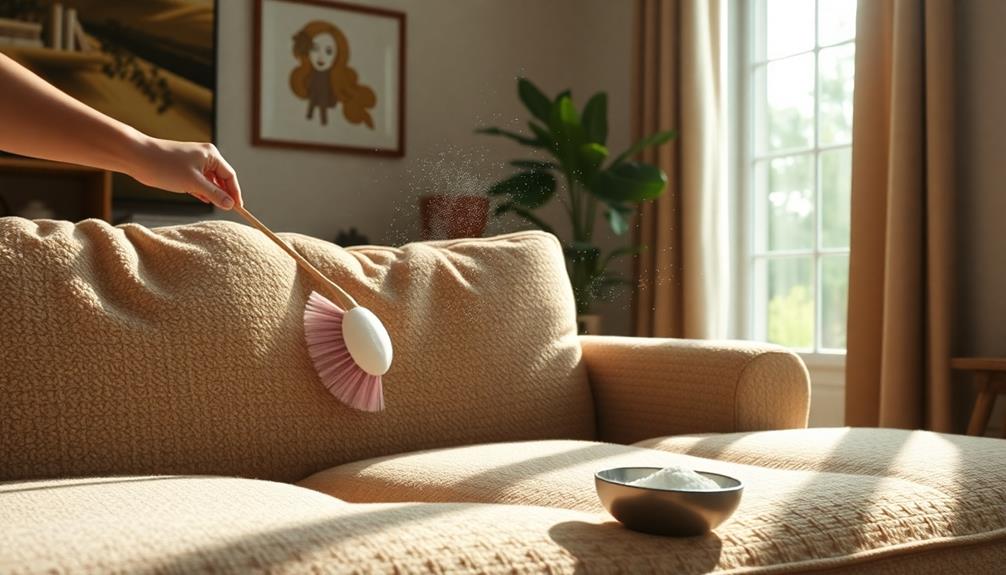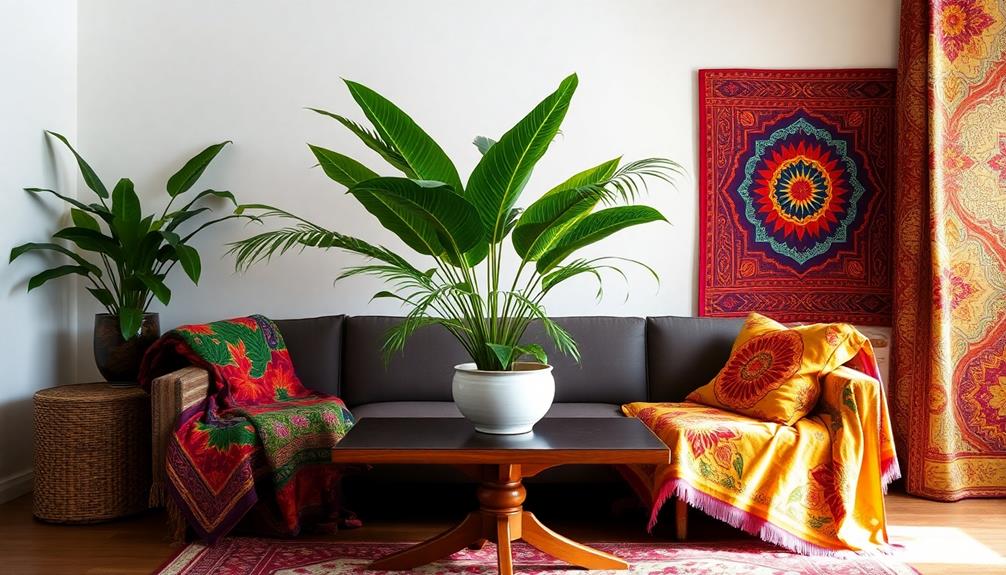To eliminate mold from wooden furniture, start by putting on protective gear such as gloves and a mask. For mild infestations, combine equal parts distilled white vinegar and water in a spray bottle, then spray it onto the affected areas and let it sit for an hour. For more stubborn mold, use a bleach solution (1 cup bleach in 1 gallon of water) and gently scrub with a stiff brush. Once the cleaning is done, ensure the furniture is completely dry in a well-ventilated area to prevent future mold growth. Additionally, maintain humidity levels below 50% to discourage mold. Further tips on keeping your furniture safe can be found below. It is crucial to regularly inspect and clean the furniture after removing the mold to prevent any recurrence. If you have other cleaning issues, like removing stains from sofa cushions, consider using a mild upholstery cleaner or a mixture of baking soda and water for targeted treatment. Consistent upkeep and proper storage are essential for preserving the durability of your wooden furniture. To provide extra protection for your wooden furniture, consider applying a protective finish like wax or oil after cleaning to help seal the surface against moisture and future mold growth. It is also important to monitor nearby upholstery; if you need to remove stains from sofa cushions, acting promptly can prevent permanent discoloration. Regular maintenance of your living space, including wooden furniture and upholstered items, will ensure a clean and healthy environment for years to come.
Key Takeaways
- Identify mold by looking for discoloration, a fuzzy texture, and a musty smell on wood furniture.
- Use a mixture of equal parts distilled white vinegar and water for light mold infestations.
- For stubborn mold, apply a bleach solution (1 cup bleach in 1 gallon water) with a stiff-bristled brush.
- After cleaning, ensure the furniture dries completely in a well-ventilated area to prevent future growth.
- Maintain indoor humidity levels below 50% and conduct regular inspections to prevent mold resurgence.
Understanding Mold and Its Risks
Mold is a common problem that can silently invade your home, especially if you have wood furniture. Mold spores are everywhere, thriving in damp and humid environments. When these spores settle on your wooden furniture, they can quickly multiply, posing significant risks to both your health and your furniture's integrity.
In fact, about 50% of homes in the U.S. face mold issues, which can severely impact indoor air quality. Understanding how to protect seniors from financial scams can also be beneficial, as mold removal services can sometimes be a target for unethical practices.
Exposure to mold can lead to various health problems, particularly respiratory issues like asthma and allergies, skin rashes, and headaches. Sensitive individuals, such as children or those with preexisting conditions, are particularly vulnerable.
Certain molds, like Stachybotrys chartarum, or black mold, are associated with even more severe health risks and require specialized cleaning solutions for removal.
To protect your wooden furniture and your health, it's crucial to keep humidity levels in check and take proactive measures to prevent mold. Regularly inspect your furniture for signs of mold and act quickly to remove mold if you notice any.
Identifying Mold on Wood

Identifying Mold on Wood
When inspecting your wood furniture, look for signs of mold, which often manifests as patches of green, black, or brown discoloration. Mold on wood may have a fuzzy or velvety texture, making it distinct from simple dirt or water stains. If you notice a musty smell, that's another strong indicator of mold presence, especially in areas with high humidity, like basements or bathrooms.
Regular cleaning and maintenance, such as preventing cross-contact in kitchens, can also help mitigate the conditions that promote mold growth.
Identifying mold isn't just about visible signs; it's crucial to differentiate between mold growth and water stains. Water stains typically don't have a fuzzy texture and are confined to specific areas, while mold can spread over time.
Regular inspections in high humidity areas can help catch mold early.
Keep in mind that the size of the mold infestation matters. If you identify mold covering an area larger than 10 square feet, it's wise to seek professional assistance for safe removal.
Always take precautions when dealing with mold, and avoid using random cleaning products that may not effectively address the issue. By knowing how to identify mold, you can take the necessary steps to protect your furniture and your health.
Essential Products for Removal

What products should you reach for when tackling mold on wood furniture? It's essential to use effective cleaning solutions to clean and remove mold safely. Here's a handy table to guide you on the best options:
| Product | Use Case |
|---|---|
| Distilled White Vinegar | Natural solution for light mold infestations |
| Hydrogen Peroxide | Effective for deeper stains |
| Borax Mixed with Warm Water | Powerful for thorough cleaning |
| Dishwashing Detergent | Gentle cleaning for mild cases |
| Commercial Products (e.g., Mold Armor) | For severe infestations |
These solutions not only assist in mold removal but also help to prevent future mold growth by disinfecting your wood surfaces. For light mold infestations, vodka can serve as a non-toxic alternative, effectively eliminating odors and killing mold spores. Remember to guarantee proper ventilation when using these products to minimize exposure to harmful fumes. Taking these steps will help you maintain a clean environment and keep your furniture safe from mold.
Steps for Removing Mold

Taking swift action is essential for effectively removing mold from your wood furniture. Start by gathering protective gear like rubber gloves, safety goggles, and an N95 mask to shield yourself from mold spores and cleaning agents.
For light mold, mix equal parts distilled white vinegar and water. This natural remedy can be quite effective, as many people have found success using natural remedies alongside conventional methods. Apply this solution to the affected area, letting it sit for an hour before wiping it off with a cloth.
If you encounter stubborn mold, use a bleach solution—mix 1 cup of bleach in 1 gallon of water. Apply it with a stiff-bristled brush, scrubbing gently to avoid damaging the wood.
After cleaning, make sure your furniture dries completely in a well-ventilated area. This step is vital to prevent future mold growth.
To keep mold at bay, conduct regular inspections and maintain indoor humidity levels below 50%. By following these steps, you can successfully remove mold from wood and protect your furniture from further contamination. Remember, the key is to act quickly and stay vigilant in your maintenance efforts.
Safety Precautions During Cleanup

Cleaning mold from wood furniture can be hazardous, so prioritizing safety is essential. Always wear protective gear, including rubber gloves, safety goggles, and an N95 mask, to minimize your exposure to harmful mold spores and cleaning agents.
Confirm the cleaning area is well-ventilated by opening windows and using fans. This helps disperse airborne mold spores and prevents you from inhaling harmful fumes from the cleaning solutions.
To further contain the cleanup, seal off the area with plastic sheeting, which will help stop mold spores from spreading to other parts of your home.
When disposing of contaminated materials, like rags and vacuum bags, use sealed plastic bags to prevent the spread of mold beyond the cleanup zone.
Additionally, be cautious when using strong chemicals, such as bleach. Always follow the manufacturer's instructions to avoid harmful reactions and confirm effective mold removal.
Advanced Removal Techniques

When tackling mold on wood furniture, a variety of advanced removal techniques can effectively restore your pieces.
Start with vinegar treatment; apply distilled white vinegar directly to the affected areas and let it sit for an hour. Its natural mold-killing properties will help eliminate the mold.
For deeper infestations, sanding is vital. Use 100-grit sandpaper and sand along the grain to minimize damage. After sanding, consider refinishing your furniture by applying a protective wood finish to restore its appearance and guard against future mold growth.
If the mold persists, you can turn to bleaching. Mix one cup of bleach with one gallon of water, then apply it using a stiff-bristled brush, remembering to scrub gently to avoid harming the wood.
Once you've tackled the mold, allow the cleaned areas to air dry completely. This step is essential in preventing any residual moisture from fostering new mold growth.
Make sure that the environment is well-ventilated during this process to aid in drying and further reduce mold risk.
Preventing Future Mold Growth

To keep mold from returning, you need to maintain indoor humidity levels between 30%-50%.
Make certain your spaces are well-ventilated, especially in kitchens and bathrooms, to prevent moisture buildup.
Regularly check for leaks in plumbing or roofing, and fix them promptly to eliminate sources of dampness.
Maintain Low Humidity
Keeping indoor humidity levels between 30-50% is essential in preventing mold growth on wood furniture. Mold thrives in high humidity environments, so maintaining ideal humidity levels is key.
You can effectively manage moisture accumulation by using dehumidifiers in damp areas like basements and bathrooms. Regularly inspect and promptly repair leaks from plumbing or roofs to prevent excess moisture from fostering mold growth. Cleaning and drying water-damaged areas within 24-48 hours is critical to avoid mold establishment on wood surfaces.
Here's a quick reference table to help you maintain low humidity:
| Action | Purpose |
|---|---|
| Use dehumidifiers | Reduce indoor humidity levels |
| Repair leaks | Prevent moisture accumulation |
| Clean water-damaged areas | Deter mold growth |
Ensure Proper Ventilation
Ensuring proper ventilation is essential for preventing mold growth on wood furniture. Maintaining humidity levels between 30-50% is critical, and effective ventilation plays a key role in achieving this.
Install exhaust fans in areas prone to moisture, like kitchens and bathrooms, and make it a habit to open windows whenever possible. This will help reduce moisture accumulation and minimize the likelihood of mold establishment on wooden surfaces.
In damp areas, like basements, consider using dehumidifiers to lower humidity and create an environment less conducive to mold spores.
Regularly inspect and clean your vents and air circulation systems to enhance airflow. Stagnant air promotes mold growth, so it's important to keep your home's ventilation system in good shape.
Additionally, spacing your furniture apart allows for better air circulation, preventing moisture build-up and reducing the risk of mold colonization on wooden surfaces.
Regularly Inspect for Leaks
Maintaining proper ventilation helps minimize moisture, but even the smallest leaks can spell trouble for wood furniture. To prevent mold growth, you need to regularly inspect for leaks, particularly in plumbing systems and roofing.
Monthly checks in high-humidity areas like kitchens, bathrooms, and basements can help you identify potential water sources before they lead to moisture accumulation.
Use moisture meters to assess humidity levels in your home; if you find readings above 50%, consider repairing leaks or implementing additional moisture control measures.
Focus on caulking and seals around sinks, bathtubs, and windows. Any cracks or deterioration in these areas can allow water to seep into wood surfaces, creating ideal conditions for mold.
Additionally, establish a routine for checking gutters and downspouts to guarantee proper drainage away from your home. Poor drainage can lead to water infiltration, increasing the risk of mold on your wooden furniture.
When to Seek Professional Help

If you notice signs of severe mold infestation, like extensive growth or a musty odor, it's time to contemplate calling in the pros.
Additionally, if you have health concerns, such as asthma or a weakened immune system, tackling mold removal on your own mightn't be safe.
Seeking professional help guarantees thorough remediation and protects your health.
Signs of Severe Infestation
Mold infestations can escalate quickly, and recognizing the signs of a severe problem is crucial for your health and safety. If you notice any of the following indicators, it's time to seek professional help:
- Visible Structural Damage: If you see warping or weakening of the wood furniture, it's a clear sign that the mold infestation has gone beyond a manageable level.
- Persistent Mold Growth: If mold keeps returning despite your DIY cleaning efforts, this suggests deeper issues that need experts.
- Location of Mold: If you find mold inside walls, ceilings, or even in your HVAC system, professional remediation services are necessary to prevent further spread and contamination.
Ignoring these signs can lead to significant health risks, especially for individuals with health concerns like asthma or weakened immune systems.
Don't compromise your safety; tackling a severe mold infestation requires expertise that only professionals can provide. Act promptly to guarantee thorough removal and protect your home and health.
Health Risks Consideration
Dealing with a mold problem can be overwhelming, especially when health risks are involved. If you or anyone in your household has pre-existing health conditions like asthma or allergies, it's vital to seek professional mold removal.
Cleaning mold can exacerbate respiratory problems and trigger severe reactions. If the mold covers an area larger than 10 square feet, don't hesitate to contact specialists; larger infestations often require advanced mold remediation techniques that go beyond DIY capabilities.
Persistent health problems—such as ongoing respiratory issues or skin irritation—warrant a visit to your healthcare provider and consideration of professional mold remediation services.
Additionally, if you discover mold hidden inside walls, ceilings, or HVAC systems, hiring professionals is essential. These areas can harbor toxic mold and pose significant health risks if not properly addressed.
Professionals not only provide effective treatment but also identify and tackle underlying moisture issues that contribute to mold growth, ensuring thorough prevention of future infestations.
Prioritize your health and safety by understanding when it's time to call in the experts.
Frequently Asked Questions
Can Moldy Wood Furniture Be Saved?
Yes, you can save moldy wood furniture if you catch the infestation early. With proper cleaning techniques and maintenance, you'll restore its appearance and prevent future mold growth, ensuring your furniture lasts longer.
What Kills Mold Spores on Wood Furniture?
To kill mold spores on wood furniture, you can use white vinegar, hydrogen peroxide, or a bleach solution. Alternatively, commercial mold removers are effective. Always test a small area first to prevent damage. When cleaning mold from furniture, it’s important to ensure you have proper ventilation in the area to avoid inhaling any spores. After applying your chosen solution, gently scrub the affected area with a soft cloth or brush to help lift the mold away. Finally, always allow the furniture to dry completely to prevent the mold from re-emerging.
Does Vinegar Remove Mold From Wood Furniture?
Yes, vinegar effectively removes mold from wood furniture. Just apply it directly to the moldy area, let it sit for an hour, then wipe it clean. It'll also help eliminate any musty odors.
Is Bleach or Vinegar Better to Kill Mold on Wood?
You might think bleach's strong smell means it's more effective, but vinegar's actually better for killing mold on wood. It penetrates deeper, is non-toxic, and prevents future growth without damaging the wood's integrity.
Conclusion
To sum up, tackling mold on your wood furniture isn't just a chore; it's an epic battle against a tiny, green menace! With the right tools and a dash of determination, you can reclaim your furniture and banish mold like a superhero. Just remember to follow the steps, don your protective gear, and keep that mold at bay! After all, your furniture deserves to shine without a sinister, fuzzy intruder lurking around! So, go forth and conquer!









